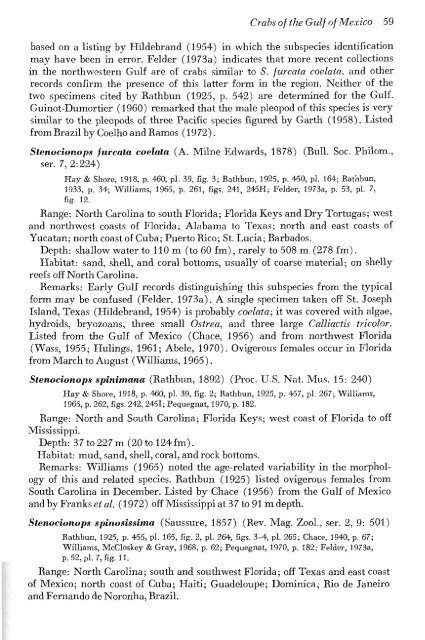Create successful ePaper yourself
Turn your PDF publications into a flip-book with our unique Google optimized e-Paper software.
Crabs of the Gulf of Mexico 59<br />
based on a listing by Hildebrand (1954) in which the subspecies identification<br />
may have been in error. Felder (1973a) indicates that more recent collections<br />
in the northwestern Gulf are of crabs similar to S. furcata coelata, and other<br />
records confirm the presence of this latter form in the region. Neither of the<br />
two specimens cited bj^ Rathbun (1925, p. 542) are determined for the Gulf.<br />
Guinot-Dumortier (1960) remarked that the male pleopod of this species is very<br />
similar to the pleopods of three Pacific species figured by Garth (1958). Listed<br />
fromBrazil by Coelho and Ramos (1972).<br />
Stenocionops furcata coelata (A. Milne Edwards, 1878) (Bull. Soc. Philom.,<br />
ser. 7,2:224)<br />
Hay & Shore, 1918, p. 460, pi. 39, fig. 3; Kathbun, 1925, p. +50, pi. 164; Kathbun,<br />
1933, p. 34; Williams, 1965, p. 261, figs. 241, 245H; Felder, 1973a, p. 53, pi. 7,<br />
fig. 12.<br />
Range: North Carolina to south Florida; Florida Keys and Dry Tortugas; west<br />
and northwest coasts of Florida; Alabama to Texas; north and east coasts of<br />
Yucatan; north coast of Cuba; Puerto Rico; St. Lucia; Barbados.<br />
Depth: shallow water to 110 m (to 60 fm), rarely to 508 m (278 fm).<br />
Habitat: sand, shell, and coral bottoms, usually of coarse material; on shelly<br />
reefs off North Carolina.<br />
Remarks: Early Gulf records distinguishing this subspecies from the typical<br />
form may be confused (Felder, 1973a). A single specimen taken off St. Joseph<br />
Island, Texas (Hildebrand, 1954) is probably coelata; it was covered with algae,<br />
hydroids, bryozoans, three small Ostrea, and three large Calliactis tricolor.<br />
Listed from the Gulf of Mexico (Chace, 1956) and from northwest Florida<br />
(Wass, 1955; Hulings, 1961; Abele, 1970). Ovigerous females occur in Florida<br />
from March to August (Williams, 1965).<br />
Stenocionops spinimana (Rathbun, 1892) (Proc. U.S. Nat. Mus. 15: 240)<br />
Hay & Shore, 1918, p. 460, pi. 39, fig. 2; Rathbun, 1925, p. 457, pi. 267; Williams,<br />
1965, p. 262, figs. 242, 2451; Pequegnat, 1970, p. 182.<br />
Range: North and South Carolina; Florida Keys; west coast of Florida to off<br />
Mississippi.<br />
Depth: 37 to 227 m (20tol24fm).<br />
Habitat: mud, sand, shell, coral, and rock bottoms.<br />
Remarks: Williams (1965) noted the age-related variability in the morphology<br />
of this and related species. Rathbun (1925) listed ovigerous females from<br />
South Carolina in December. Listed by Chace (1956) from the Gulf of Mexico<br />
and by Franks et al. (1972) off Mississippi at 37 to 91 m depth.<br />
Stenocionops spinosissima (Saussure, 1857) (Rev. Mag. Zool., ser. 2, 9: 501)<br />
Rathbun, 1925, p. 455, pi. 165, fig. 2, pi. 264, figs. 3^., pi. 265; Chace, 1940, p. 67;<br />
Williams, McCloskey & Gray, 1968, p. 62; Pequegnat, 1970, p. 182; Felder, 1973a,<br />
p.52,pl. 7,fig. 11.<br />
Range: North Carolina; south and southwest Florida; off Texas and east coast<br />
of Mexico; north coast of Cuba; Haiti; Guadeloupe; Dominica; Rio de Janeiro<br />
and Fernando de Noronha, Brazil.

















